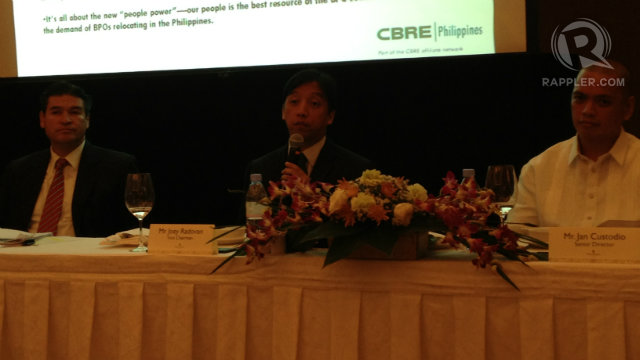SUMMARY
This is AI generated summarization, which may have errors. For context, always refer to the full article.

MANILA, Philippines – Office space occupied by the steadily growing business process outsourcing (BPO) industry will double by 2017, according to real estate consultancy company CB Richard Ellis (CBRE) Philippines.
“Taking a conservative approach, the BPO industry will double up by 2017 and will come up to close to 5 million square meters,” said Joey Radovan, vice chairman of CBRE, at a press briefing on Wednesday, June 5.
According to Radovan, the main factor behind BPO industry growth is cost. “The Philippines is one of the most cost-effective and attractive destinations for BPOs and real estate investors in Asia,” he said.
The BPO industry is on track to hitting its 2016 targets of $25 billion revenues and 1.3 million employees, according to the Information Technology and Business Process Association of the Philippines (IBPAP).
“To reach our 2016 targets, we reiterate that it is imperative that we sustain and strengthen the work we are doing with government. We have received impressive support from President Aquino and his teams in the executive branch and we were able to pass key legislation needed by the industry,” said Jomari Mercado, IBPAP president and CEO, at the Cebu ICT and BPO Conference, on Wednesday, June 5.
According to Mercado, the industry earned about $13.2 billion in revenues for the country in 2012, a growth of 19% from 2011.
It is this growth that boosts office leasing transactions. Vacancy rating of offices in Metro Manila dropped to 3.21% in the first quarter of 2013 from the record 3.43% in the fourth quarter of 2012.
“Cost-sensitive BPO firms tend to locate themselves in areas which offer the lowest lease rates,” said Radovan.
Currently, Alabang, Muntinlupa and Quezon City offer the lowest lease rates.
According to CBRE figures, occupancy rates were set at 97% across Metro Manila’s central business districts (CBDs) during the first quarter of 2013, an increase from the 90% recorded since 2011. The growth of BPO full-time employees was highest in BGC, Muntinlupa and Quezon City.
The following is a breakdown of Manila’s different CBD’s according to CBRE:
- Makati – High-value global and local firms tend to situate their offices in the CBD because Makati currently offers the highest quality Grade A and premium office buildings available in the market.
- Fort Bonifacio – Over the years, Fort Bonifacio has undergone continuous growth with the development of numerous office buildings catering to both corporate back-office and headquarters. Leasing activity in the district was largely driven by the continuous expansion of offshoring and outsourcing firms.
- Ortigas – The business district offers the lowest lease rates as it tries to compete with other business districts that are offering newer and more efficient office spaces.
- Alabang – BPO offices in Alabang remain fully occupied while traditional offices, which have observed continuous drop in occupancy, were able to leverage the continuous drop in demand by cutting its rates.
- Quezon City – Leasing activity in Quezon City is constrained because of the extremely low vacancy level in the district as offshoring and outsourcing firms continue to occupy the office spaces in the district.
– Rappler.com
Add a comment
How does this make you feel?
There are no comments yet. Add your comment to start the conversation.